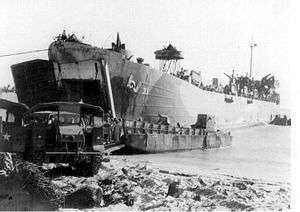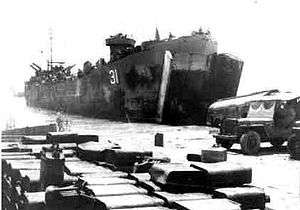USS LST-31
 LST-31 off-loading over the beach at Englhi Island, Eniwetok Atoll, Marshall Islands, c. February–March 1944 | |
| History | |
|---|---|
| Name: | USS LST-31 |
| Builder: | Dravo Corporation, Pittsburgh, Pennsylvania |
| Laid down: | 2 February 1943 |
| Launched: | 5 June 1943 |
| Commissioned: | 21 July 1943, as USS LST-31 |
| Decommissioned: | 8 January 1946 |
| Honors and awards: | 5 battle stars |
| Renamed: | USS Addison County, 1 July 1955 |
| Namesake: | Addison County, Vermont |
| Struck: | 11 August 1955 |
| Fate: | Sunk as a target |
| General characteristics | |
| Class and type: | LST-1-class tank landing ship |
| Displacement: |
|
| Length: | 328 ft (100 m) |
| Beam: | 50 ft (15 m) |
| Draft: |
|
| Depth: | 8 ft (2.4 m) forward, 14 ft 4 in (4.37 m) aft (full load) |
| Propulsion: | 2 General Motors 12-567 diesel engines, two shafts, twin rudders |
| Speed: | 12 knots (22 km/h; 14 mph) |
| Boats & landing craft carried: | Two or six LCVPs |
| Troops: | 14-16 officers, 131-147 enlisted men |
| Complement: | 7-9 officers, 104-120 enlisted men |
| Armament: |
|
USS Addison County (LST-31) was an LST-1-class tank landing ship built for the United States Navy during World War II. Named for Addison County, Vermont, she was the only U.S. Naval vessel to bear the name.
LST-31 was laid down on 2 February 1943 at Pittsburgh, Pennsylvania by the Dravo Corporation; launched on 5 June 1943; sponsored by Mrs. Maurice Endres; accepted by the Navy and placed in reduced commission on 10 July 1943; and sailed to New Orleans where she was placed in full commission on 21 July 1943 with Lieutenant John D. Schneidau, Jr., USNR, in command.
Service history
1943
The new tank landing ship got underway on 29 July for Panama City, Florida where she conducted a series of beaching exercises. LST-31 returned to New Orleans on 7 August to take on cargo for transportation to the Pacific. After a brief port call at Guantanamo Bay, Cuba the vessel transited the Panama Canal on 24 August and joined the Pacific Fleet. She then continued on to San Diego, California where she arrived on 13 September.
After participating in beaching exercises in the San Diego area, the ship stopped at Port Hueneme and at San Francisco, California to take on cargo. She left the west coast on 15 October bound for Hawaii, reached Pearl Harbor on the 25th, and began unloading. When this task was completed, LST-31 again weighed anchor on 5 November and shaped a course for the Gilbert Islands. As a member of 5th Amphibious Force, the ship was slated to take part in the assault on Makin Island. LST-31 arrived off Makin on the 20th and began discharging troops and cargo ashore. She remained off that atoll until 3 December, when she got underway to return to Pearl Harbor. Shortly after her arrival, the vessel entered the Pearl Harbor Navy Yard for repairs and alterations. While her engines were being overhauled, additional 40-millimeter and 20-millimeter guns were installed. The yard period ended in early January 1944, and the refurbished vessel then took part in training exercises off Maui in preparation for the forthcoming invasion of the Marshall Islands.
1944
The tank landing ship left Pearl Harbor on 19 January and set a course for Kwajalein. She anchored off that atoll on 1 February and began discharging her cargo in support of operations in the Marshalls. On 12 February, the ship began embarking troops for the invasion of Eniwetok and, five days later, sortied with LST Group 8. She beached at Eniwetok on the 20th and began landing her soldiers and discharging cargo ashore. LST-31 remained there until 20 March, when she got underway for Hawaii. She stopped en route at Kwajalein and Tarawa to take on cargo and passengers and finally reached Pearl Harbor on 15 April. Following repairs in drydock there, she resumed operations on 10 May with a series of training exercises in Hapuna Bay, Hawaii. On the 25th, LST-31 left Hawaiian waters, bound for Eniwetok. Upon her arrival at that atoll on 7 June, she refueled and took on cargo in preparation for operations against Saipan. The vessel arrived off Saipan on 14 June and began discharging troops and supplies ashore. She cleared the area on the 23rd and returned to Eniwetok to replenish her cargo.
LST-31 arrived back at Saipan on 17 July; unloaded supplies and small craft; and, during the next few weeks, served as a hospital ship. At night, she anchored off Saipan to receive casualties and was underway off Tinian during daylight hours. This assignment occupied the ship through 21 August, when she began a round-trip voyage to Eniwetok. After returning to Saipan, the vessel underwent three days of voyage repairs and got underway on 23 September for the west coast of the United States. En route, she touched at Eniwetok; Apamama and Makin Islands, Gilbert Islands; and Pearl Harbor. She left the latter port on 6 November and reached San Francisco on 17 November 1944. After one day in port there, LST-31 sailed to San Pedro to enter the West Coast Shipbuilding Company yards for extensive alterations and repairs.
1945
The ship left the yard in early February 1945, conducted sea trials, and arrived at the Mare Island Navy Yard, Vallejo, California on 18 February to take on an amphibious craft. She then visited Seattle, Washington for additional repair work. On 10 March, the vessel got underway for Hawaii and reached Pearl Harbor on the 23rd.

LST-31 left Hawaii on 4 April for Okinawa. She embarked passengers and loaded supplies at Eniwetok and Guam before proceeding on to the Ryūkyūs and anchoring in waters off southwestern Okinawa on 3 May. She remained in the area for approximately three weeks providing logistic support to troops fighting on Okinawa. The ship arrived at Ulithi on 28 May; took on cargo; and, on 2 June, set a course for the island of Leyte in the Philippines. During the months of June, July, and August, LST-31 operated between the Philippines and Okinawa, transporting supplies and troops between the two points to build up Okinawa as a base for the conquest of the Japanese home islands. However, this invasion was obviated when Japan capitulated on 15 August. The ship then began moving occupation troops and equipment to Japan from various points in the Philippines. She first arrived in Japanese waters on 15 September, when she dropped anchor in Tokyo Bay.
On 30 November, LST-31 was assigned to duty in Japan with the 5th Fleet, Amphibious Group 11, LST Flotilla 35. However, these orders were superseded late in December; and the ship was slated for decommissioning. She was scheduled to be turned over to the Japanese merchant marine to be manned by a Japanese crew under American control for use in repatriating Japanese citizens and shuttling supplies between Japanese ports.
1946–1955
After the ship was stripped of all armament and other wartime equipment, LST-31 was decommissioned on 8 January 1946 and transferred to the Japanese. The vessel operated under Japanese control into May 1948, when she was returned to U.S. Naval custody. She left Yokohama on the 3rd of that month and shaped a course for the west coast of the United States. The tank landing ship was later berthed in the Seattle area. On 1 July 1955 LST-31 was named the USS Addison County. Her name was struck from the Naval Vessel Register on 11 August 1955 and she was subsequently sunk as a target.
Awards
During World War II, LST-31 served in the Asiatic-Pacific Theater and participated in the Gilbert Islands operation (November and December 1943); the Marshall Islands operation, (a) occupation of Kwajalein and Majuro Atolls (January and February 1944), and (b) occupation of Eniwetok Atoll (February and March 1944); Marianas operation, (a) capture and occupation of Saipan (June to August 1944); Tinian capture and occupation (July and August 1944); and Okinawa Gunto operation, assault and occupation of Okinawa Gunto (May 1945). Addison County earned five battle stars for her World War II service.
References
This article incorporates text from the public domain Dictionary of American Naval Fighting Ships.
- "Addison County". Dictionary of American Naval Fighting Ships. Retrieved 2 April 2007.
- "LST-31 Addison County". Amphibious Photo Archive. Retrieved 2 April 2007.